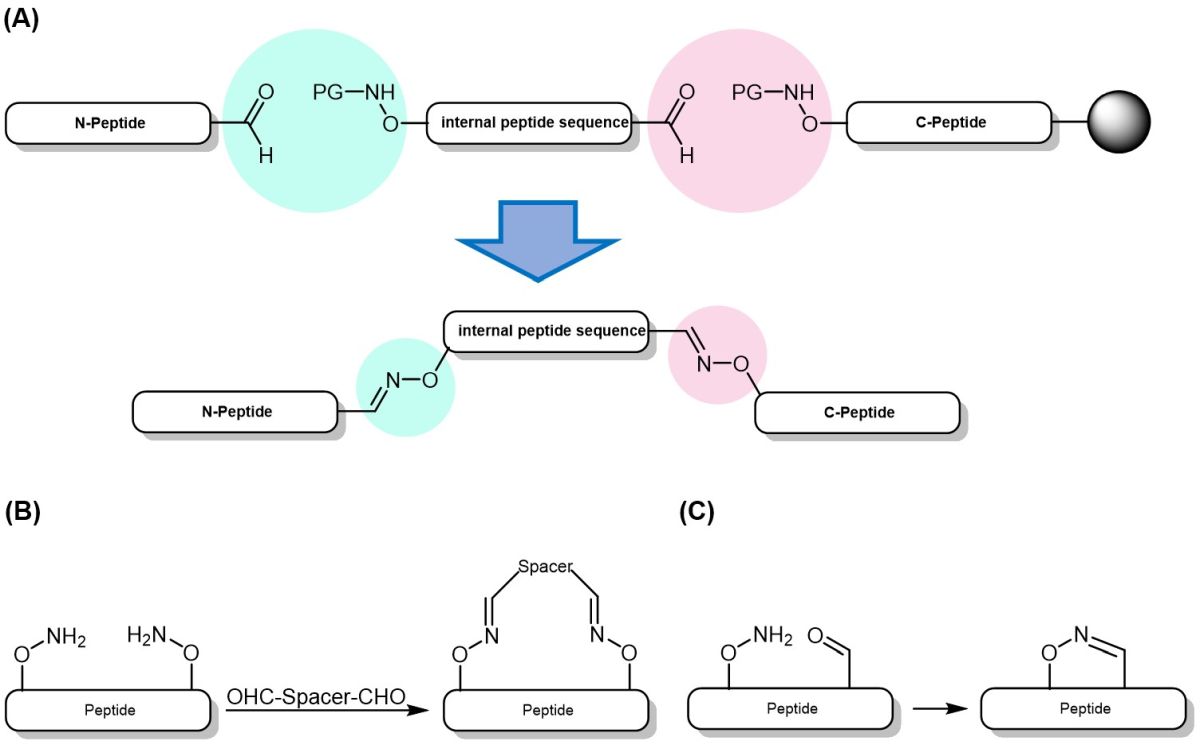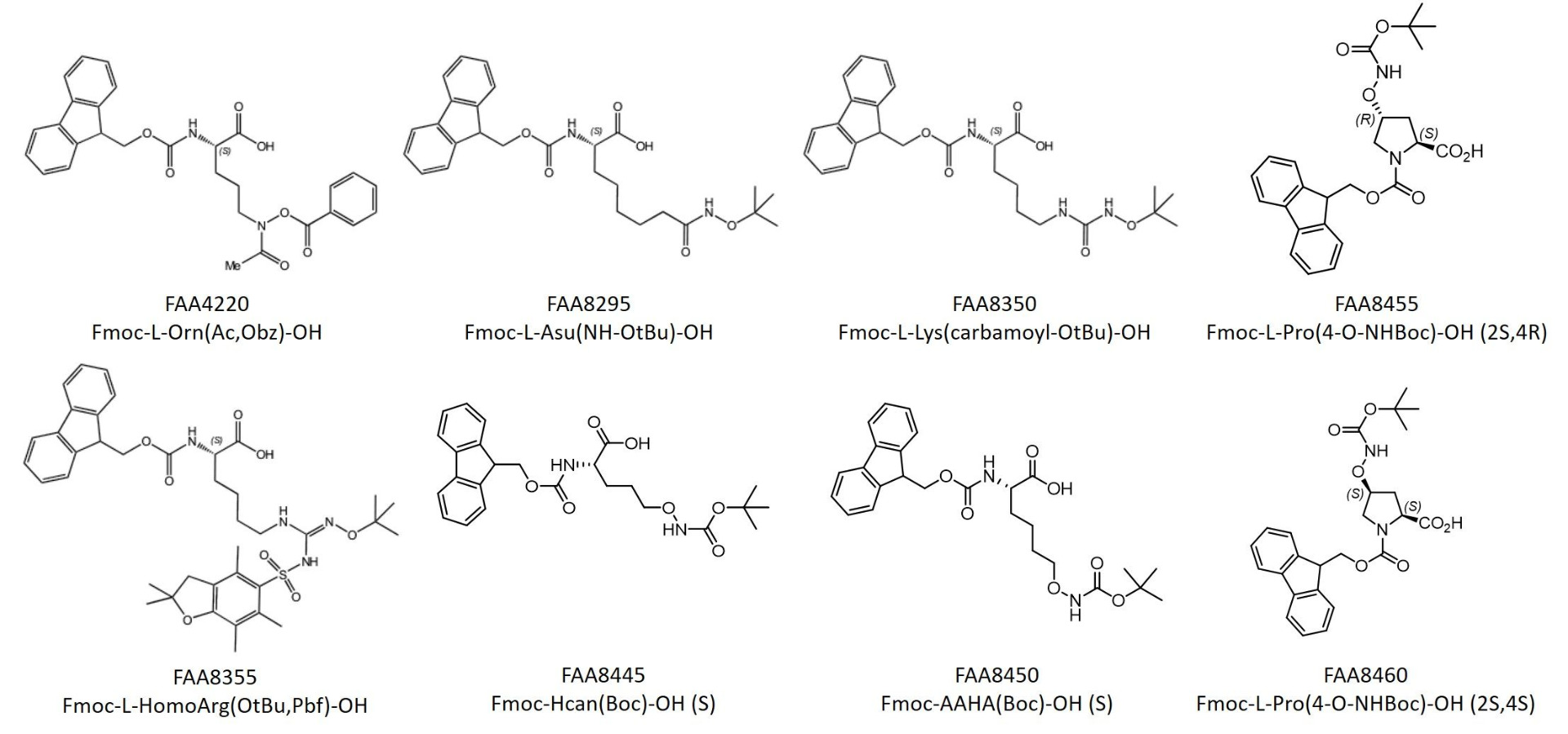Welcome to Iris Biotech
For better service please confirm your country and language we detected.

For better service please confirm your country and language we detected.

Thank you very much for your interest in our products. All prices listed on our website are ex-works, Germany, and may attract customs duties when imported.
You may/will be contacted by the shipping company for additional documentation that may be required by the US Customs for clearance.
We offer you the convenience of buying through a local partner, Peptide Solutions LLC who can import the shipment as well as prepay the customs duties and brokerage on your behalf and provide the convenience of a domestic sale.
Continue to Iris Biotech GmbHSend request to US distributorPublished on 23.03.2021

Over the last years, several articles about aminooxy-amino acid derivatives were published. Within the following, we are aiming at giving a brief review about various applications that are possible with aminooxy-derivatives offered by Iris Biotech.
Replacing the primary amino group of an amino acid by an aminooxy moiety leads to an increase in nucleophilicity. Thus, after completion of the peptide synthesis and deprotection of the aminooxy-function, chemoselective reactions with carbonyl compounds under formation of a kinetically stable oxime bond can be performed. Compared to imines, oximes display much higher stability toward hydrolysis. This increased nucleophilicity and stability is explained by the α-effect provided by the heteroatom adjacent to the sp2 nitrogen.

Mechanism of aldoximine/ketoxime formation upon reaction of an aminooxy derivative with an aldehyde or ketone, respectively.
This simple reaction can be utilized for the synthesis of large proteins by fragment assembly (A) or for the preparation of cyclic peptides (B, C). In the first case, successive deprotection of aminooxy moieties allows for the controlled and sequential ligation of peptide fragments. The latter one, peptide cyclization, imposes significant conformational constraints on peptide folding that is essential for biological activity. As exemplified in nature, this typically occurs via disulfide bridges between thiol-containing residues. Using aminooxy derivatives, peptide cyclization can either be achieved by reacting an aminooxy and aldehyde side chain within one peptide sequence, or via bridging of two aminooxy side chains and a dialdehyde linker.

Illustration of exemplary applications of aminooxy derivatives: (A) Fragment condensation via oxime ligation. (B) and (C) Cyclization via oxime formation.
Besides oxime formation, the aminooxy moiety allows for chemoselective side-chain modification, e.g. for the formation of glycoconjugates. The reaction of a reducing carbohydrate with an aminooxy group leads to unnatural, N-glycosylated peptides named neo-glycopeptides. Those constructs are valuable tools for the ease of investigation of the influence of glycosylation patterns on structure and function of peptides and proteins. One key advantage of this approach is that a single peptide, synthesized by SPPS, can easily be reacted with a variety of sugars providing a whole library for structure-activity studies.
Furthermore, the aminooxy moiety can act as a donor group for chelation. As an example, our hydroxamate-ornithine derivative N-delta-hydroxy-N-delta-acetyl-ornithine (FAA4220) is a bidentate ligand that is found in many siderophores. Siderophores are known for the formation of stable hexadentate octahedral complexes with Fe3+ and other metal ions. They are taken up by specific microbial receptors and transport systems, a property that can be exploited to deliver antibiotics via Siderophore-Drug-Conjugates. Since it bypasses the bacterium’s defences, this method is aptly termed the “Trojan Horse” strategy. Another example were chelation plays a crucial role, are Histone deacetylase (HDAC) inhibitors. HDACs are pivotal enzymes in the regulation of gene expression and can be efficiently inhibited by substrate peptidomimetic inhibitors (SPIs), as shown by Jamieson et al. The inhibiting properties of SPIs stem from the presence of non-natural amino acids able to coordinate the HDAC active site zinc(II).
This multitude of examples highlights the potential and versatility of aminooxy amino acid derivatives. Iris Biotech offers corresponding building blocks compatible with standard SPPS protocols.

References:
Synthesis of HDAC Substrate Peptidomimetic Inhibitors Using Fmoc Amino Acids Incorporating Zinc-Binding Groups; A. Mahindra, C. J. Millard, I. Black, L. J. Archibald, J. W. R. Schwabe and A. G. Jamieson; Org Lett 2019; 21: 3178-3182. https://doi.org/10.1021/acs.orglett.9b00885.
Site-specific cross-linking of proteins to DNA via a new biorthogonal approach employing oxime ligation; S. S. Pujari, Y. Zhang, S. Ji, M. D. Distefano, N. Y. Tretyakova; Chem. Commun. 2018; 54: 6296-6299. https://doi.org/10.1039/C8CC01300D. https://doi.org/10.1016/j.bmcl.2015.03.069.
Chemoselectively addressable HCan building blocks in peptide synthesis: L-homocanaline derivatives; I. Lang, N. Donzé, P. Garrouste, P. Dumy, M. Mutter; J. Pept. Sci. 1999; 4(1): 72-80. https://doi.org/10.1002/(SICI)1099-1387(199802)4:1<72::AID-PSC130>3.0.CO;2-G.
Synthetic derivatives of the SUMO consensus sequence provide a basis for improved substrate recognition; M. J. Leyva, Y. S. Kim, M. L. Peach, J. S. Schneekloth, Bioorg Med Chem Lett. 2015; 25(10): 2146-2151. https://doi.org/10.1016/j.bmcl.2015.03.069.
Receptor-templated stapling of intrinsically disordered peptide ligands; C. M. Haney, W. S. Horne; Org. Biomol. Chem. 2015; 13: 4183-4189. https://doi.org/10.1039/C5OB00269A.
44. Amino-oxy-derivatives. Part I. Some a-amino-oxy-acids and a-amino-oxy-hydrazides. D. Mchale, J. Green, P. Mamalis; J. Chem. Soc. 1960; 225-229. https://doi.org/10.1039/JR9600000225.
Structural Investigation of Hybrid Peptide Foldamers Composed of a-Dipeptide Equivalent b-Oxy-d5-amino Acids; R. M. Reja, V. Kumar, G. George, R. Patel, K. R. P. Kumar, S. Raghothama, H. N. Gopi; Chem. Eur. J. 2020; 26(19): 4304-4309. https://doi.org/10.1002/chem.201904780.
Cross-Linked Collagen Triple Helices by Oxime Ligation; N. B. Hentzen, L. E. J. Smeenk, J. Witek, S. Riniker, H. Wennemers; J. Am. Chem. Soc. 2017; 139 (36): 12815-12820. https://doi.org/10.1021/jacs.7b07498.
Protected aminooxyprolines for expedited library synthesis: Application to Tsg101-directed proline-oxime containing peptides; F. Liu, A. G. Stephen, R. J. Fisher, T. R. Burke; Med. Chem. Lett. 2008; 18: 1096-1101. https://doi.org/10.1016/j.bmcl.2007.12.003.
SAR by Oxime-Containing Peptide Libraries: Application to Tsg101 Ligand Optimization; F. Liu, A. G. Stephen, A. A. Waheed, M. J. Aman, E. O. Freed, R. J. Fisher, T. R. Burke; ChemBioChem 2008; 9(12): 2000-2004. https://doi.org/10.1002/cbic.200800281.
A Versatile Set of Aminooxy Amino Acids for the Synthesis of Neoglycopeptides; M. R. Carrasco, R. T. Brown; J. Org. Chem. 2003; 68: 8853-8858. https://doi.org/10.1021/jo034984x.
The many roles of histone deacetylases in development and physiology: implications for disease and therapy; M. Haberland, R. L. Montgomery and E. N. Olson; Nat Rev Genet 2009; 10: 32-42. https://doi.org/10.1038/nrg2485.
Sirtuins as regulators of metabolism and healthspan; R. H. Houtkooper, E. Pirinen and J. Auwerx; Nat Rev Mol Cell Biol 2012; 13: 225-238. https://doi.org/10.1038/nrm3293.
Loss of acetylation at Lys16 and trimethylation at Lys20 of histone H4 is a common hallmark of human cancer; M. F. Fraga, E. Ballestar, A. Villar-Garea, M. Boix-Chornet, J. Espada, G. Schotta, T. Bonaldi, C. Haydon, S. Ropero, K. Petrie, N. G. Iyer, A. Perez-Rosado, E. Calvo, J. A. Lopez, A. Cano, M. J. Calasanz, D. Colomer, M. A. Piris, N. Ahn, A. Imhof, C. Caldas, T. Jenuwein and M. Esteller; Nat Genet 2005; 37: 391-400. https://doi.org/10.1038/ng1531.
Histone-deacetylase inhibitors: novel drugs for the treatment of cancer; R. W. Johnstone; Nat Rev Drug Discov 2002; 1: 287-99. https://doi.org/10.1038/nrd772.
Zinc-dependent Deacetylase (HDAC) Inhibitors with Different Zinc Binding Groups; Y. Li, F. Wang, X. Chen, J. Wang, Y. Zhao, Y. Li and B. He; Curr. Top. Med. Chem. 2019; 19: 223-241. https://doi.org/10.2174/1568026619666190122144949.
Chemistry and biology of siderophores; R. C. Hider and X. Kong; Nat. Prod. Rep. 2010; 27: 637-657. https://doi.org/10.1039/b906679a.
Beyond iron: non-classical biological functions of bacterial siderophores; T. C. Johnstone and E. M. Nolan; Dalton Trans 2015; 44: 6320-6339. https://doi.org/10.1039/c4dt03559c.
Enterobactin-Mediated Delivery of β-Lactam Antibiotics Enhances Antibacterial Activity against Pathogenic Escherichia coli; T. Zheng and E. M. Nolan; J. Am. Chem. Soc. 2014; 136: 9677-9691. https://doi.org/10.1021/ja503911p.
Staphyloferrin A as siderophore-component in fluoroquinolone-based Trojan horse antibiotics; S. J. Milner, A. Seve, A. M. Snelling, G. H. Thomas, K. G. Kerr, A. Routledge and A.-K. Duhme-Klair; Org Biomol Chem 2013; 11: 3461-3468. https://doi.org/10.1039/c3ob40162f.
Siderophore-Mediated Cargo Delivery to the Cytoplasm of Escherichia coli and Pseudomonas aeruginosa: Syntheses of Monofunctionalized Enterobactin Scaffolds and Evaluation of Enterobactin–Cargo Conjugate Uptake; T. Zheng, J. L. Bullock and E. M. Nolan; J. Am. Chem. Soc. 2012; 134: 18388-18400. https://doi.org/10.1021/ja3077268.
Chemical synthesis and biological evaluation of gallidermin-siderophore conjugates; S. Yoganathan, C. S. Sit and J. C. Vederas; Org. Biomol. Chem. 2011; 9: 2133-2141. https://doi.org/10.1039/c0ob00846j.
Exploiting bacterial iron acquisition: siderophore conjugates; C. Ji, R. E. Juarez-Hernandez and M. J. Miller; Future Med. Chem. 2012; 4: 297-313. https://doi.org/10.4155/fmc.11.191.
Design and synthesis of a siderophore conjugate as a potent PSMA inhibitor and potential diagnostic agent for prostate cancer; P. Ding, P. Helquist and M. J. Miller; Bioorg. Med. Chem. 2008; 16: 1648-1657. https://doi.org/10.1016/j.bmc.2007.11.030.
Design and synthesis of a novel protected mixed ligand siderophore; P. Ding, C. E. Schous and M. J. Miller; Tetrahedron Lett. 2008; 49: 2306-2310. https://doi.org/10.1016/j.tetlet.2008.02.007.
Siderophore-antibiotic conjugates used as trojan horses against Pseudomonas aeruginosa; H. Budzikiewicz; Curr. Top. Med. Chem. 2001; 1: 73-82. https://doi.org/10.2174/1568026013395524.
Siderophore-dependent iron uptake systems as gates for antibiotic Trojan horse strategies against Pseudomonas aeruginosa; G. L. Mislin and I. J. Schalk; Metallomics: integrated biometal science 2014; 6: 408-20. https://doi.org/10.1039/c3mt00359k.
Siderophores as drug delivery agents: application of the "Trojan Horse" strategy; U. Mollmann, L. Heinisch, A. Bauernfeind, T. Kohler and D. Ankel-Fuchs; Biometals : an international journal on the role of metal ions in biology, biochemistry, and medicine 2009; 22: 615-24. https://doi.org/10.1007/s10534-009-9219-2.
Oxime Ligation: A Chemoselective Click-Type Reaction for Accessing Multifunctional Biomolecular Constructs; S. Ulrich, D. Boturyn, A. Marra, O. Renaudet, P. Dumy; Chem. Eur. J. 2013; 20(1): 34-41. https://doi.org/10.1002/chem.201302426.
Studies and syntheses of siderophores, microbial iron chelators, and analogs as potential drug delivery agents; J. M. Roosenberg, 2nd, Y. M. Lin, Y. Lu and M. J. Miller; Curr. Med. Chem. 2000; 7: 159-97. https://doi.org/10.2174/0929867003375353.
Iron transport-mediated drug delivery using mixed-ligand siderophore-β-lactam conjugates; A. Ghosh, M. Ghosh, C. Niu, F. Malouin, U. Moellmann and M. J. Miller; Chem. Biol. 1996; 3: 1011-1019. https://doi.org/10.1016/S1074-5521(96)90167-2.